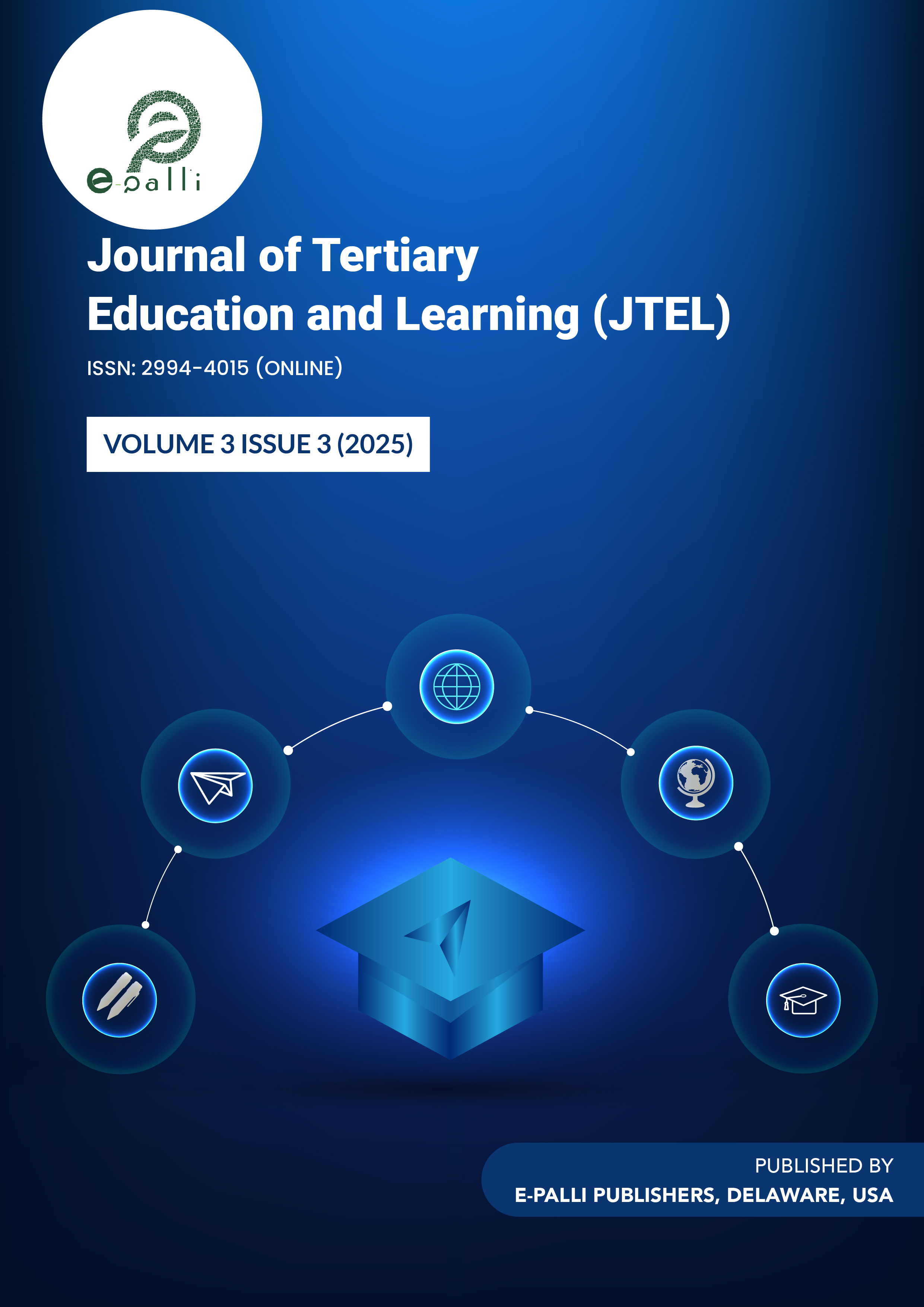Crafting a Responsive Teaching Framework for Data Analysis: A Phenomenological Study on Students’ Experiences in Learning Descriptive and Inferential Statistics
DOI:
https://doi.org/10.54536/jtel.v3i3.5483Keywords:
Instructional Framework, Phenomenological Study, Scaffolded Teaching, Statistics Education, Student ExperiencesAbstract
This present study employed the qualitative phenomenological approach in acquiring data regarding the lived experiences of 26 third-year BEED students at a local community college in the Philippines in learning descriptive and inferential statistics within the research coursework context. The thematic findings revealed that students find their experiences in learning statistics very much characterized by anxiety and confusion, followed by slowly developing self-confidence in understanding complicated concepts, formulas, and the usage of statistical software. Some of the common challenges faced included choosing an appropriate statistical test, interpreting the results, and applying their knowledge of statistics to real-world research issues. However, they cited several strategies used in instruction that helped them to understand most of these aspects, such as step-by-step and structured explanations, use of practical and real-life data, hands-on activities, support and patience by the instructor, visual aids, and collaborative group work. This study is grounded in Ausubel’s theory of meaningful learning, thereby stressing the connection of new knowledge to the pre-existing cognitive structures of the learner. Following from these insights, the study proceeds to propose the Scaffolded Teaching Approach to Transform Statistics Learning (S.T.A.T.S. Framework)—an innovative student-centered framework that seeks to bring in diagnostic assessment, thematic instruction, active engagement, technology-enhanced learning, and regular reflective feedback. The S.T.A.T.S. Framework is aimed at addressing the barriers to statistics education by reducing anxiety, enhancing accessibility in statistical learning, and promoting both statistical literacy and self-efficacy. The study holds implications for educators interested in molding higher education data analysis instruction into being effective, responsive, and inclusive.
References
Adolfo, J. & Villarin, S. (2023). Influence of Word Games to Students’ Vocabulary Achievement. International Journal of Multidisciplinary Approach and Studies, 10(4). http://dx.doi.org/10.13140/RG.2.2.31389.90085/1
Aquino, R. & Samuel, F. D. (2022). Dispositional Antecedents of Statistics Anxiety and Its Influence on Statistics Performance Among Senior High School Students: A Structural Equation Modeling. Psychology and Education: A Multidisciplinary Journal, 2(5), 2-13. https://doi.org/10.5281/zenodo.6780428
Ausubel, D. (1963) The Psychology of Meaningful Verbal Learning. Grune & Stratton, New York.
Barcelona, A. B., Baraquiel, J. A., Cupo, E. B., Ferreras, E. T., Galarion, C. G., Yabut, L. A., & Zapanta, J. R. A. (2023). Statistical anxiety and teacher presence among graduate students: A moderation analysis. American Journal of Education and Learning, 8(1), 76-87. https://www.researchgate.net/publication/368791018
Casinillo, L. F. (2022). On modelling student’s resilience in learning statistics at a distance. The Palawan Scientist, 14(2), 85-93. https://www.palawanscientist.org/tps/wp-content/uploads/2022/12/10_Casinillo_On-modelling-students-resilience.pdf#:~:text=2,Students%E2%80%99%20Resilience%20Level
Creswell J. W. & Plano Clark V. L. (2011). Designing and conducting mixed methods research (2nd). SAGE.
Creswell, J. W. (2013). Qualitative inquiry and research design: choosing among five approaches (3rd ed.). Sage Publications.
Creswell, J. W. (2007). Qualitative inquiry & research design: Choosing among five approaches (1st ed). SAGE Publications, Inc.
Dani, A., Al Quraan, E. (2023). Investigating research students’ perceptions about statistics and its impact on their choice of research approach. Heliyon, 9(10). https://pmc.ncbi.nlm.nih.gov/articles/PMC10562852/
Douglas, D. (2024). Teaching statistics for the social sciences using active learning: A case study. Education Sciences, 14(11), 1163. https://doi.org/10.3390/educsci14111163
Dumale, C. P. & Gurat, M. G. (2023). Pedagogical Approaches in Statistics and Probability during Pandemic. American Journal of Educational Research, 11(6), 337-347. https://ssrn.com/abstract=4752523
Gabio, J. A., & Cajandig, A. J. S. (2025). College of Teacher Education students’ mastery of statistical concepts: Basis for proposed enhancement program. International Journal of Research and Innovation in Social Science (IJRISS), 9(3). https://dx.doi.org/10.47772/IJRISS.2025.90300179
Hood-DeGrenier, J. K. (2015). A Strategy for Teaching Undergraduates to Write Effective Scientific Results Sections. CourseSource. https://doi.org/10.24918/cs.2016.13
Hunt, B. W., Mari, T., Knibb, G., Christiansen, P., Jones, A. (2023) Statistics anxiety and predictions of exam performance in UK psychology students. PLoS ONE, 18(8), e0290467. https://doi.org/10.1371/journal.pone.0290467
Idris, K. (2018). Teaching and learning statistics in college: How learning materials should be designed. Journal of Physics: Conference Series, 1088, 012032. https://doi.org/10.1088/1742-6596/1088/1/012032
Levpušček Puklek, M., & Čukon, M. (2022). That old devil called ‘Statistics’: Statistics anxiety in university students and related factors. CEPS Journal, 12(1), 147–168. https://doi.org/10.25656/01:24398
Lim, S. W. H., Ng, G. J. P., & Wong, G. Q. H. (2015). Learning psychological research and statistical concepts using retrieval-based practice. Frontiers in Psychology, 6, Article 1484. https://doi.org/10.3389/fpsyg.2015.01484
March, J. J., Hamilton, D., McCormack, D., Brisco, R., & Grech, A. (2025). A network analysis of statistics anxiety symptoms and their antecedents in UK higher education students. Annals of the New York Academy of Sciences, 1547(1), 220-232.
Moustakas, C. (1994). Phenomenological research methods. SAGE Publications, Inc. https://dx.doi.org/10.4135/9781412995658
Naval, R. C., Eraña, I. & Pablo, P. (2022). Students’ Understanding of Basic Statistics in Modular Distance Learning: Basis For Learning Material Enhancement. SARIRIT: The University Research Journal (formerly QSU Research Journal), 11(1). https://ejournals.ph/article.php?id=19526#:~:text=results%20of%20the%20assessments%20revealed,the%20use%20of%20blended%20learning
Repedro, Jr., R. E., & Diego, C. V. (2021). Attitudes toward Statistics and Statistical Literacy of Public Senior High School Students. Philippine Social Science Journal, 4(3), 48-56. https://doi.org/10.52006/main.v4i3.399
Schreiter, S., Friedrich, A., Fuhr, H., Malone, S., Brünken, R., Kuhn, J., & Vogel, M. (2024). Teaching for statistical and data literacy in K-12 STEM education: a systematic review on teacher variables, teacher education, and impacts on classroom practice. ZDM–Mathematics Education, 56(1), 31-45. https://doi.org/10.1007/s11858-023-01531-1
Tucker, M. C., Shaw, S. T., Son, J. Y., & Stigler, J. W. (2022). Teaching statistics and data analysis with R. Journal of Statistics and Data Science Education, 30(1), 18–32. https://doi.org/10.1080/26939169.2022.2089410
Wahba, F., Ajlouni, A. O., & Abumosa, M. A. (2024). The impact of ChatGPT-based learning statistics on undergraduates’ statistical reasoning and attitudes toward statistics. EURASIA Journal of Mathematics, Science and Technology Education, 20(7), em2468. https://doi.org/10.29333/ejmste/14726
Yang, D. Instructional strategies and course design for teaching statistics online: perspectives from online students. International Journal of STEM Education 4, 34 (2017). https://doi.org/10.1186/s40594-017-0096-x
Downloads
Published
How to Cite
Issue
Section
License
Copyright (c) 2025 Sydney Jay B. Villarin, Grace C. Lapinig, Divina Gracia C. Divino, Kemski P. Lumahang, Lily France J. Echavez

This work is licensed under a Creative Commons Attribution 4.0 International License.






